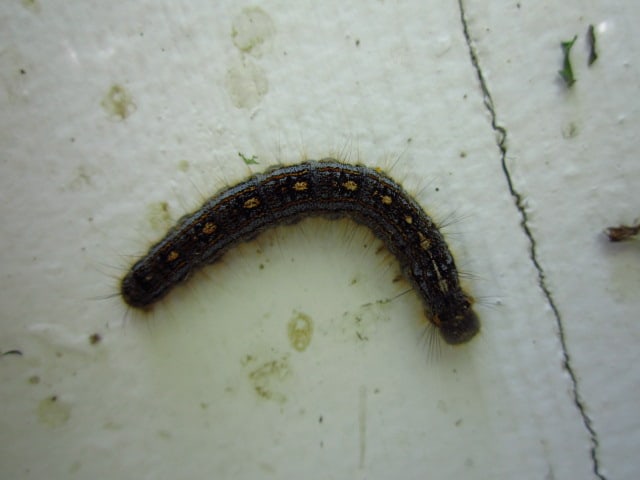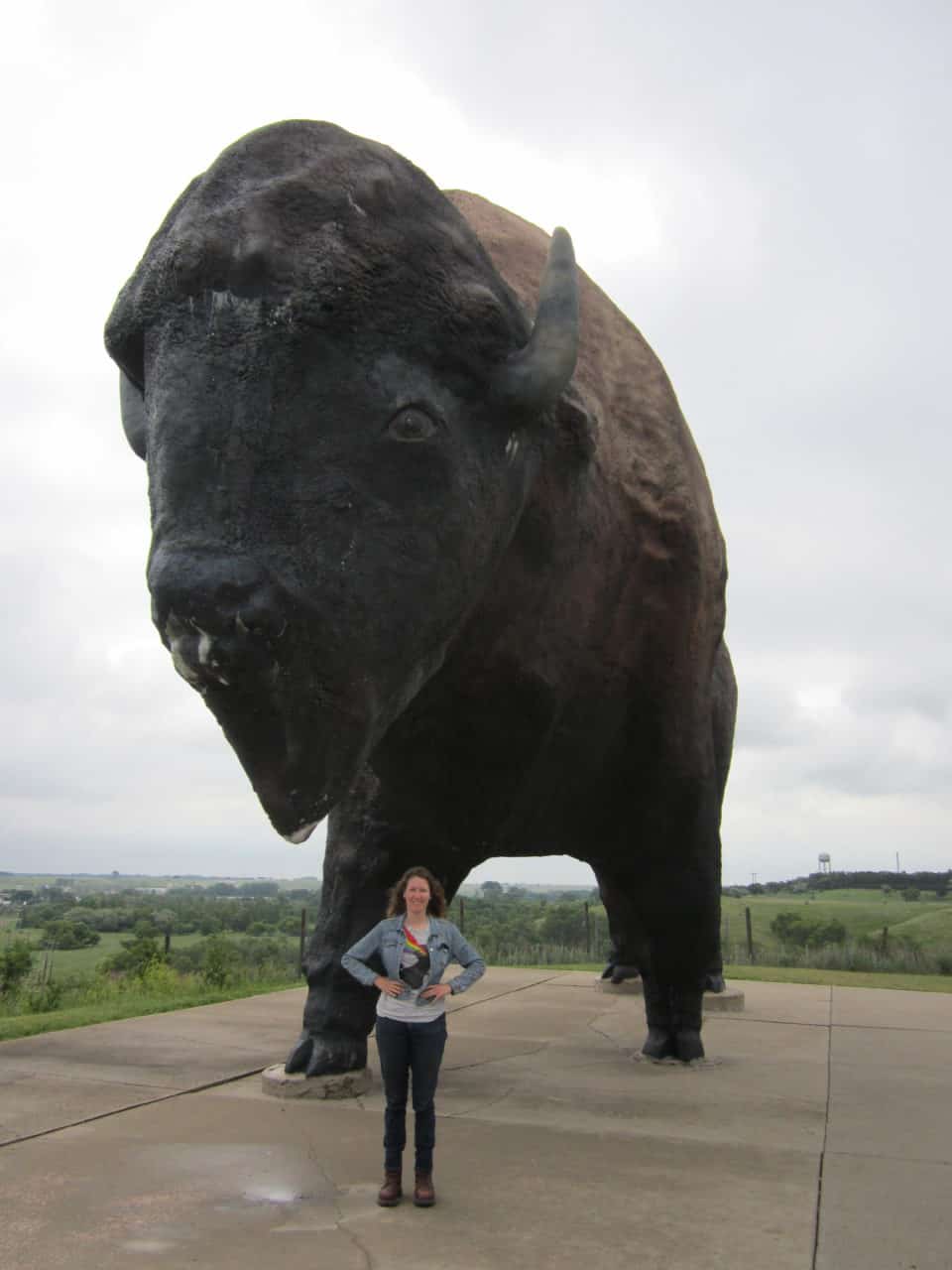In early June I experienced an outbreak of forest tent caterpillars (FTC), Malacosoma disstria, while sampling at an apiary in west-central Minnesota. Not only were the hive lids covered with frass, the technical term for insect feces, but the caterpillars themselves were falling on both the lids and my shoulders as I worked. According to the Minnesota Department of Natural Resources, FTC has been in the outbreak stage in west-central counties of Minnesota for several years, potentially numbering from one to four million caterpillars per acre. In between outbreaks FTC can be nearly undetectable. The larval caterpillars emerge from over-wintered egg masses around mid-May and…
Year: 2012
Observing retinue behavior.
On Thursday, Mike and I attempted to observe retinue behavior. So what is retinue behavior? Retinue behavior is the action of worker bees towards the queen including antennating, grooming and trophallaxis. A substance produced by the mandibular glands of the queen is thought to be the trigger for this retinue behavior. Antennating is the tapping movement of the antennae displayed by the bees in the presence of a queen. Grooming consists of worker bees cleaning and managing the appearance of the queen. Trophallaxis is the transfer of food or communication with the queen. To observe retinue behavior we followed the protocol complied by Dr. Yusuf…
Cycle of a Northern CA Bee Breeder
Most commercial beekeepers will tell you that beekeeping has changed dramatically in the last 30 years coinciding with the arrival of Varroa mites in the late 80’s. It seems as though things have been in a constant state of change since then as beekeepers and scientists scramble to understand the complexities of Varroa, viruses, Nosema ceranae, pesticides and how they interact with bees, both, alone and in combination. The days of setting bees down in a single location and letting them go until it was time to extract honey are far gone. Now, commercial beekeepers start to fall behind if they are not making their…
Smoker Plug
It has been really busy out in the Midwest recently. Liz and I visited nine beekeepers in North Dakota the past week. Once I catch up with the work, I will write more about the experience. But for now, here is something on smokers. Having your smoker puff billows of smoke out of your truck bed can prompt concerned drivers to warn you your truck is on fire. To prevent your smoker from getting you pulled over, you can either put it in a metal box or you can use something to plug the hole. To plug the hole you can use something like grass…
Wormlion (Vermilionidae)
On a recent trip I stumbled onto pits in sandy soil. The first thing that came to mind was Antlions which congregate in dry soil. They sit in the bottom of the pits and wait for unsuspecting prey to fall in. Upon further investigation I found that there were small worm-like larvae in the bottom of these pits. They were somewhat strange looking having no pronounced prolegs or large sclerotinized mandibles to grab prey with. So once I figured out that these were not Antlions I figured I’d throw in some prey to see what happened. When I did, I was surprised. The larvae grabbed…
The Ropes of Research – Learning My Way Around a New World
When I think back to when I first started as an apiary technician at the Pennsylvania Department of Agriculture the first thing that comes to my mind is how completely clueless I was when it came to beekeeping. I also had a lot to learn about scientific research. The more I learned the more I realized how little I actually knew. An answer to one question almost always leads to another question... I will never forget my first day in the field at a yard just outside the small town of Lewisburg, Pennsylvania. Dennis vanEngelsdorp and I met Jeff Pettis and Nathan Rice (USDA Bee…
Busy Bees at BRL
The past month has been very busy for us at the Bee Research Lab in Maryland. There was one week we received shipments of alcohol samples from all 3 BIP teams: California, Minnesota and Hawaii. It was only a few weeks ago when we had boxes stacked high waiting to be processed. I am proud to say that Heather Eversole and I broke our own personal records for how many samples we could process in a day. It feels good knowing that the beekeepers received their reports as fast as possible! As most of you know, my primary task at BRL is counting Nosema spores.…
Velvet Ants (Mutillidae)
On a recent adventure into the Ishi Wilderness...(http://en.wikipedia.org/wiki/Ishi_Wilderness) I stumbled onto my second Velvet Ant (Mutillidae) in California. This one was similar to the first species I saw. There are a few images below that show the first one I collected. Mike also found a Velvet Ant that looked to be the same species. Velvet ants are so named because of their dense hair that can be gold, black, orange or a variety of other colors. I have both specimens in captivity now. One fascinating thing I found about these ants is they make squeaking noises by stridulation which means that they make sounds by…
The Midwest at its Best
Not many Californians would jump at the opportunity to spend their summer in Minnesota and North Dakota, but not many Californians work with bees either. I was glad to be given the opportunity to work with Katie Lee in the Bee Informed Partnership and pack my bags and relocate to St. Paul at the beginning of June. For the past four years I've worked with Sue Cobey at UC Davis, learning how to keep bees and raise queens, working my way up to a full time position taking care of the research hives and lab facilities at the Harry Laidlaw Honey Bee Research Facility. My…
Bee Beard
http://www.youtube.com/watch?v=MiVTZbISMcE Last Saturday Rob and I volunteered to participate in the Patrick Ranch’s annual Country Faire and Threshing Bee. For more information about the event visit: http://site.patrickranchmuseum.org/index.html We got a call from Yvonne Koehnen earlier last week asking if we would be interested in doing a bee beard for the honey bee exhibit at the fair. The Koehnen family has been beekeeping since 1907. For more on the Koehnen family visit: http://www.koehnen.com/ I had never done a bee beard before so I was excited about the invitation. We put our weekend plans to fish the McCloud River on hold and happily accepted Yvonne’s invitation. There…


